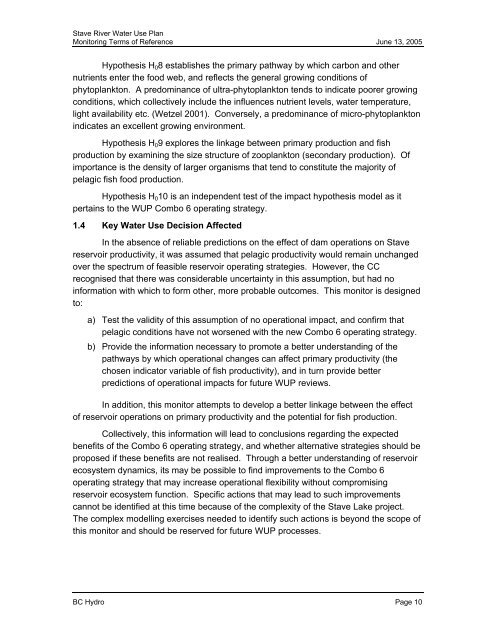Stave River Water Use Plan - BC Hydro
Stave River Water Use Plan - BC Hydro
Stave River Water Use Plan - BC Hydro
You also want an ePaper? Increase the reach of your titles
YUMPU automatically turns print PDFs into web optimized ePapers that Google loves.
<strong>Stave</strong> <strong>River</strong> <strong>Water</strong> <strong>Use</strong> <strong>Plan</strong><br />
Monitoring Terms of Reference June 13, 2005<br />
Hypothesis H08 establishes the primary pathway by which carbon and other<br />
nutrients enter the food web, and reflects the general growing conditions of<br />
phytoplankton. A predominance of ultra-phytoplankton tends to indicate poorer growing<br />
conditions, which collectively include the influences nutrient levels, water temperature,<br />
light availability etc. (Wetzel 2001). Conversely, a predominance of micro-phytoplankton<br />
indicates an excellent growing environment.<br />
Hypothesis H09 explores the linkage between primary production and fish<br />
production by examining the size structure of zooplankton (secondary production). Of<br />
importance is the density of larger organisms that tend to constitute the majority of<br />
pelagic fish food production.<br />
Hypothesis H010 is an independent test of the impact hypothesis model as it<br />
pertains to the WUP Combo 6 operating strategy.<br />
1.4 Key <strong>Water</strong> <strong>Use</strong> Decision Affected<br />
In the absence of reliable predictions on the effect of dam operations on <strong>Stave</strong><br />
reservoir productivity, it was assumed that pelagic productivity would remain unchanged<br />
over the spectrum of feasible reservoir operating strategies. However, the CC<br />
recognised that there was considerable uncertainty in this assumption, but had no<br />
information with which to form other, more probable outcomes. This monitor is designed<br />
to:<br />
a) Test the validity of this assumption of no operational impact, and confirm that<br />
pelagic conditions have not worsened with the new Combo 6 operating strategy.<br />
b) Provide the information necessary to promote a better understanding of the<br />
pathways by which operational changes can affect primary productivity (the<br />
chosen indicator variable of fish productivity), and in turn provide better<br />
predictions of operational impacts for future WUP reviews.<br />
In addition, this monitor attempts to develop a better linkage between the effect<br />
of reservoir operations on primary productivity and the potential for fish production.<br />
Collectively, this information will lead to conclusions regarding the expected<br />
benefits of the Combo 6 operating strategy, and whether alternative strategies should be<br />
proposed if these benefits are not realised. Through a better understanding of reservoir<br />
ecosystem dynamics, its may be possible to find improvements to the Combo 6<br />
operating strategy that may increase operational flexibility without compromising<br />
reservoir ecosystem function. Specific actions that may lead to such improvements<br />
cannot be identified at this time because of the complexity of the <strong>Stave</strong> Lake project.<br />
The complex modelling exercises needed to identify such actions is beyond the scope of<br />
this monitor and should be reserved for future WUP processes.<br />
<strong>BC</strong> <strong>Hydro</strong> Page 10
















